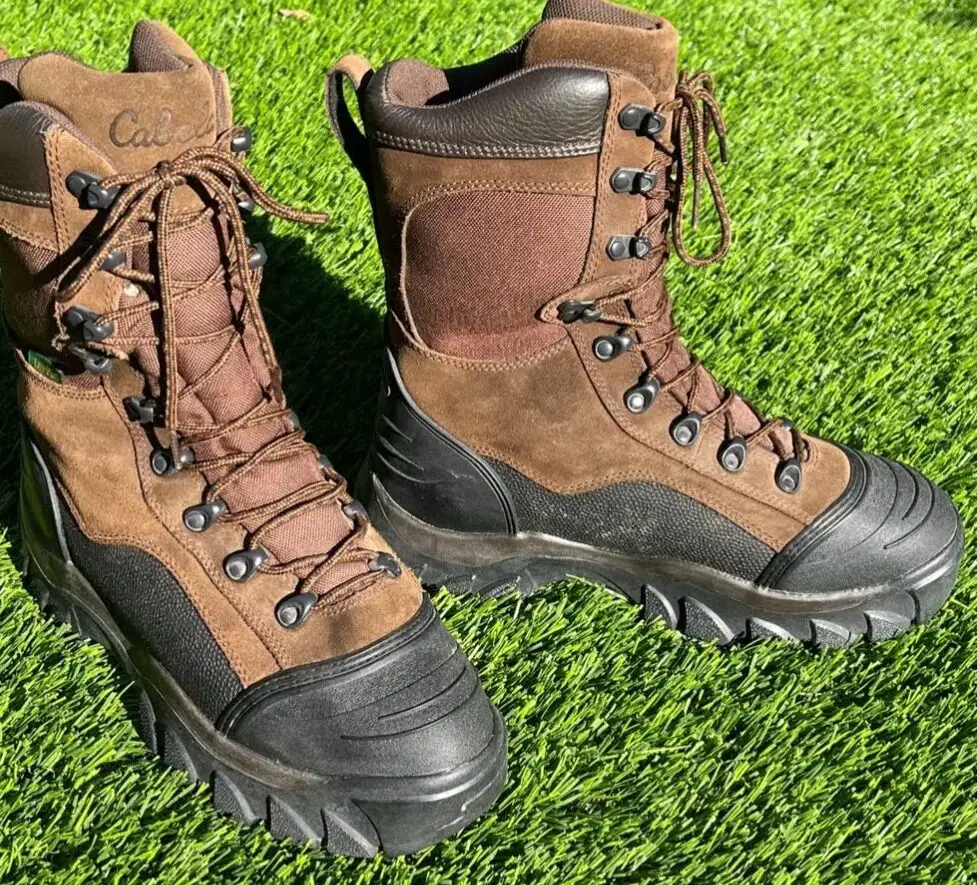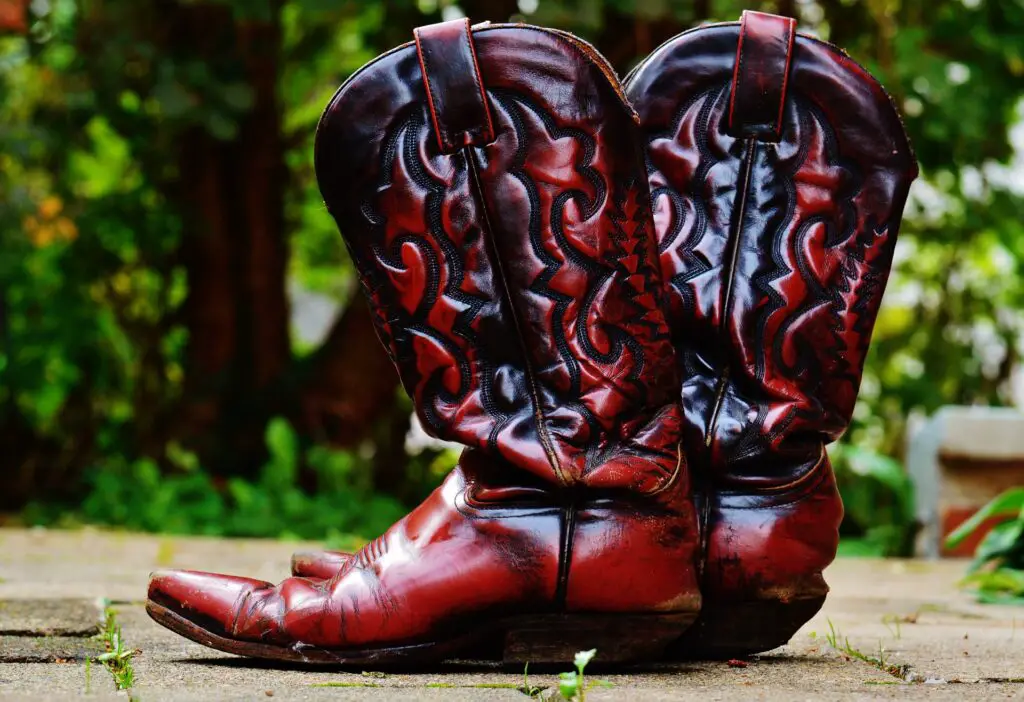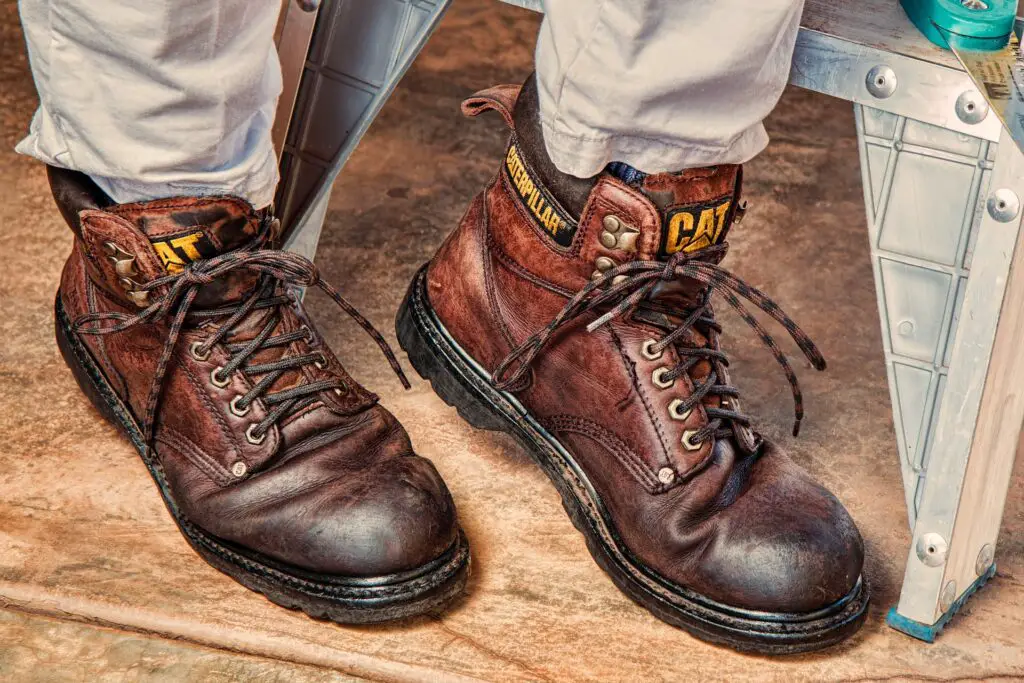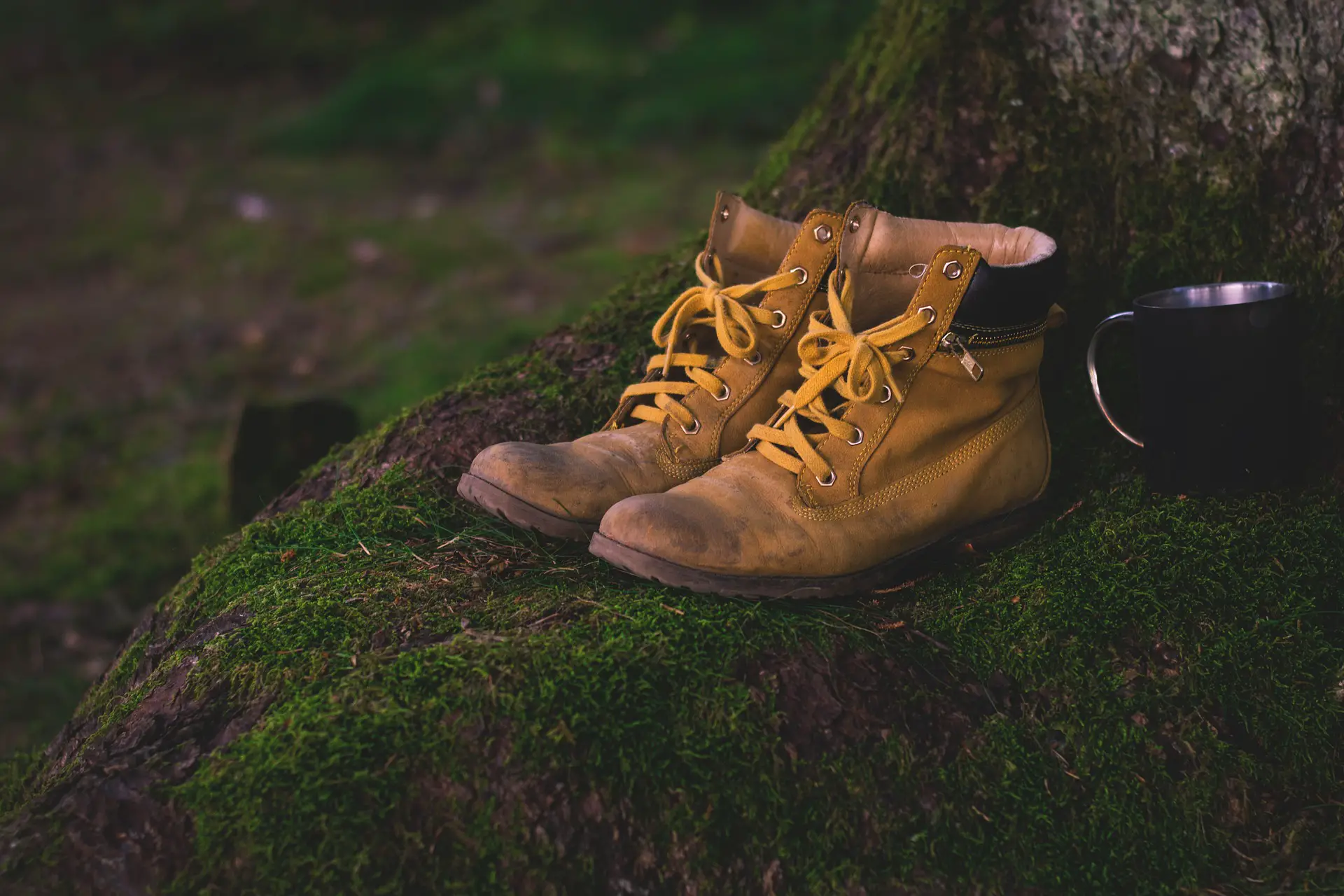Boots are unique footwear that often hold a very specific utilitarian approach in your closet and life. Getting the fit right is important, whether they’re cowboy boots, hiking boots, leather dress boots, or steel-toed work boots. When you first go to purchase a pair of boots, you need to understand if they will loosen over time.
Most boots do slightly loosen over time as they are worn repeatedly. Leather boots stretch a little bit to mold around the wearer’s foot, while the padding in synthetic boots, like those for hiking, compresses over time. Boots will expand at most to a half size over their lifetime, plus some extra near the end of life.
Each type of boot stretches in different ways and different amounts, so I’ve written about how to take care of each in this article. There are also methods for quickening and containing the stretch in different materials, which we’ll cover below.
How Boots Stretch and Loosen Over Time
Your feet take quite a beating every day, especially when you’re doing something vigorous like hiking or working outside. This beating is often extended to whatever shoes you’re wearing. Whether it’s rubbing back and forth or just repeated pressure against certain areas, it’ll both stretch and wear the material the boots are made from.
Most of the stretch or loosening that you notice from a pair of boots comes from the material softening and molding around your foot, not necessarily from the material stretching out. As the material softens it will feel bigger as the tight spots give way.
Shoes that are either too tight or too loose, or even are just the wrong shape for your feet, can contribute to moderate to severe health problems including pain, foot deformities, and neuropathy (source ). This makes it even more important to get the correct fit of boots.
). This makes it even more important to get the correct fit of boots.
Different Boot Materials
Boots are primarily made of either leather or some mix of synthetic materials. Both of these types do stretch a little bit, and there are methods described below for how to do so. Other boot materials like rubber or plastic don’t stretch or mold to your feet.
Leather Boots
Leather is a strong and durable material that can last a really long time if prepared and taken care of properly. It stretches more than many man-made materials, which means you can get a really comfortable fit in a pair of boots without as much padding as can be found in other kinds of boots.
The stretch in leather is more due to the softening of the material than the actual stretching of the hide. The original rigidity can feel constricting, but as it softens it will mold better around your feet.
Leather boots may not feel perfectly comfortable from the onset since the material hasn’t yet molded to fit your feet. They can be pretty stiff at first, so plan on breaking them in a little bit before wearing them for long, arduous days.
Synthetic Materials
Most modern hiking boots and workwear boots are made from synthetic materials, or a combination of synthetic and leather. Regardless of whether it’s one or both, the interiors are usually made from solely synthetic materials.
Synthetic materials are usually more cost-effective than leather and can be made with no animal products, which may matter to certain communities.
Most synthetic materials don’t really stretch, but they do compress over time. When you first put on a pair of boots the padding is nice and comfortable. Over time it gets worn and compressed, which can make the boots fit more loosely.

How Different Types of Boots Stretch
There are four main types of boots that are made from different materials and different combinations of materials. The proper fit for each differs, as do expectations for the amount they’ll stretch over their lifetimes.
Hiking Boots
It’s really important for hiking boots to fit well before you take them on a long trek into the woods. Otherwise they’ll cause blisters and hot spots and can present a safety concern on a longer hike.
The other issue with ill-fitting hiking boots is that if they’re too loose then your feet may slide around inside and can make you slip on difficult terrain. This is especially a concern on trails with loose gravel or on bouldering sections where you need very precise footwork.
Do Hiking Boots Stretch Out?
Hiking boots made from synthetic materials do stretch out 1/4 to 1/2 size over time as the padding in the shoes compresses down, but the materials don’t stretch and mold around your feet like leather does. Leather hiking boots mold around your feet in a way that feels like they stretch, which can make them more comfortable.
Waterproof hiking boots like those that utilize Gore-Tex usually stretch less and are more rigid. The inside padding still compresses over time so you may get a little bit of extra space inside over the life of the boots, but not much.
Towards the end of life of hiking boots, synthetic materials especially, the boots can get really loose and stretch even more. I think we’ve all experienced hiking in boots where the soles are starting to fall off and there are holes blown out in the toes and sides.
Should Hiking Boots be Tight or Loose?
Hiking Boots need to be tight enough to keep your feet from sliding around inside, but not so tight that they will pinch or rub any one spot and cause blisters. They need to be loose enough around the toes that your toes aren’t forced to rub together, but tight enough that your feet don’t slide forward into the front of the shoe while hiking downhill.
It’s really important to also keep in mind that your feet expand during the day by up to a quarter size, so if you’re trying on a pair in the morning then make sure to account for that. If they fit snugly in the morning, they may be too tight by the end of a long day of hiking.
Additionally, be sure to consider what socks you usually wear hiking along with the temperatures you hike in. Heavy wool socks are a lot thicker than thin synthetic socks, and can affect the fit of your boots by almost a half size.
Hiking socks can be a really important piece of your hiking kit for keeping your feet happy. I’ve written more about them in my article, Why are Hiking Socks Important? 7 Things Regular Socks Can’t Do
If you end up with boots that are a bit too loose, you can always wear an extra pair of socks with them. This is a great method for reducing the occurrence of blisters, but also for filling extra space in boots.
Is it Better for Hiking Boots to be Bigger or Smaller?
It is better for hiking boots to be a bit bigger than to be a bit smaller or too tight if you have to decide between the two. This is because your feet expand a little over the course of a hike. Additionally, you can wear an extra pair of socks to fill in the space in bigger boots.
Smaller, tighter hiking boots will inevitably cause blisters on hiker’s toes and in other areas, which can be disastrous on a longer or multi-day hike.
How to Stretch Out Hiking Boots to Get a Better Fit
Step 1: Buy the Right Size in the First Place
Any stretching of hiking boots will be minimal, and will only work on specific areas that are tight against the uniqueness of your foot. You can’t compensate for a poor fit by trying to stretch them out. This is especially true around the toe area.
Step 2: Wear them Around the House
Wear your boots around the house as much as you can during the first week or two. Use the hiking socks you intend to wear, as the thickness may differ from regular socks. They’ll start to form creases on the top along the ball of your foot, which you can bend back and forth when you aren’t wearing them to hasten the process.
Step 3: Take them Around the Neighborhood
After a week or two, start wearing them on walks around the neighborhood- again, with the same hiking socks you plan to use for your trek. Don’t just stick to sidewalks or roads either- it’s important to start simulating more inconsistent terrain by walking through grassy or rocky areas. Consider carrying a loaded pack as well if you plan to use them for backpacking.
Step 4: Treat Problem Spots
After wearing them for around 100 hours then it’s time to treat any problem spots that remain. This is often a hot spot on the heel or on the sides of the ball of your foot. These are the methods for treating problem spots that can be used.
- Use a Boot Stretcher in certain areas
- Use a Hairdryer to warm them up while wearing them (don’t burn the leather)
- Use alcohol or Shoe Stretch Spray
 so soften the material and stretch them by wearing them
so soften the material and stretch them by wearing them - Take them to a Cobbler or specialty Gear Store
I’ve also written previously about how to stretch out climbing shoes and also whether you should buy climbing shoes a size bigger
and also whether you should buy climbing shoes a size bigger .
.

Cowboy Boots
Cowboy Boots may be the most rigid of all leather boots, which means you’re sure to have a few spots that need special treatment. The rigidity is what makes them ultra durable and can make them last virtually forever as long as they’re somewhat taken care of.
It’s really important to get the right fit from the start so that they go on and off without too much struggle. Boots should fit fairly tight at first, though not so much that your feet hurt anywhere. Pay special attention to the width of the shoes, as they always come in narrow, regular, and wide.
Do Cowboy Boots Stretch Out?
Leather Cowboy boots are so stiff when they’re new that they need to be broken in to be comfortable. Breaking them in makes them stretch and mold around the contours of your feet. Cowboy boots will generally stretch about a half size around tight areas.
They will feel ‘bigger’ and much more comfortable once you break in the tough leather around where your foot bends at your toes. Faux leather or other synthetic cowboy boots do not stretch as much, but still should mold around your feet in problem areas.
Should Cowboy Boots be Tight or Loose?
When purchasing a new pair of Cowboy Boots, you should ensure they fit your foot snugly around the ball of your feet where any stretch will be minimized. There should be ample space at the end of the toes, and shouldn’t be any uncomfortable pressure elsewhere.
One test is to walk downhill or lightly kick against a wall to test if your toes will slide out to the end. If they go out to the end, they are too loose (or too short). This will certainly cause blisters or toe problems in the long run as they’re worn.
Is it Better for Cowboy Boots to be Bigger or Smaller?
It’s better for Cowboy Boots to fit a little bit bigger since otherwise they can be very difficult to slip on. They need to fit your arches and the balls of your feet snugly, but it’s okay if there’s some space around the heel and there needs to be space around the toes.
How to Stretch out Cowboy Boots to get a Better Fit
Like Hiking Boots detailed above, the best thing to do is just to wear them in manageable increments and allow them to stretch naturally. Remove them before any hot spots or blisters form, which can be covered with duct tape or an extra pair of socks to delay the blister.
Use alcohol or shoe stretch spray or boot cream to moisten the leather in tight areas and then wear them with extra socks while they dry. Alternatively, you can freeze bags of water in each boot overnight which will provide a stretch of up to a half size.
It’s important to make sure the leather does not dry out too much or crack, as this will ruin the boots. Condition the leather with boot cream to keep it pliable.
Dress Boots
The category of dress boots refers to men’s and women’s everyday boots, but that serve no particular function like cowboy boots or steel toes do. These are primarily supposed to be part of an outfit and generally don’t get a ton of walking in.
The problem with not getting a ton of walking in is that it can be difficult to really ‘break’ them in so that they’re comfortable. Often made of leather, these boots can be very rigid and uncomfortable in the beginning.
Do Dress Boots Stretch Out?
Dress boots stretch more than many other types of boots because they’re generally made of softer leather as they aren’t intended to take a beating like Cowboy Boots or Work Boots. They will often stretch up to a full size if necessary.
How to Stretch Dress Boots to Get the Best Fit
The methods for stretching out dress boots are the same as for hiking boots as described in detail above, with the exception of needing to wear them on uneven surfaces to prep them for the trail. Since there’s little ‘performance’ involved with these boots, it probably makes sense to just treat any hot spot from the onset with the heat or shoe spray method.

Steel-Toed Work Boots
I remember getting my first pair of steel toes when I worked in an aerospace manufacturing plant. The company provided a voucher that would cover up to a certain amount at a local workwear store. I ended up buying a cheaper boot that would be covered by the voucher, but they were pretty uncomfortable and bulky.
The boots I got were a little too narrow around the balls of my feet so I sized up. This meant my toes had a ton of space and my feet slid around inside a little bit. In hindsight, and knowing what I know now, I would have stuck with the smaller size and just tried to stretch out that specific area with shoe spray or a boot stretcher.
Now, had I been willing to shell out another $50 or so for a nicer pair of boots, they would have fit my feet better and been more comfortable overall. Either way though, I never ended up dropping anything on my toes anyway.
Do Steel-Toed Work Boots Stretch?
The area around the toe box doesn’t stretch at all, so it’s important that any boot you choose fits well in that area. The rest of the boot will usually stretch up to a half size if you really work on them using the boot stretcher, warmth, or spray methods.
Steel toes are usually more rigid than other types of boots because they’re designed to be more durable and actually protect your feet from the dangers of the workplace. The leather can be thicker, which can take longer to soften from wear.
Remember that your feet will expand during the day, especially if you work in a job that requires steel toes and has you on your feet.
How to Stretch Steel-Toed Work Boots for the Best Fit
The same methods work for Steel Toes that work for the other types of boots, with the exception of the toe box. Start with the right size and then wear them in more of a controlled setting before tackling a full day’s work.
Use shoe stretch spray or alcohol to moisten the leather and then wear them with an extra pair of socks while they dry. The hairdryer method also works, or some people freeze bags of water inside the boots so that they expand and stretch the material.
Tips for Getting the Right Fit for Boots
The best way to get a good fit for boots is obviously going to be to go to a shoe store and have them measure your feet. Often the length of your arch is more important than the length of your feet for boots.
It can be very helpful to try on several different brands as well as sizes, since they all fit slightly differently. In today’s world with the ubiquity of online shopping however, that isn’t always possible. Here are some tips for getting the best fit for your feet.
Heel
There’s actually a lot of variety in the size of everyone’s heels, perhaps more so than in other parts of the feet. Someone’s weight, genetics, and the amount of time they spend on their feet can contribute to this.
Since your feet gradually expand during the day, a little bit of space around your heel is okay. As you break in the boots they’ll mold around your foot and fill in some of that space, up to about a fourth of an inch.
Watch out for boots that put too much pressure on your Achilles tendon as well- sometimes the angle is just different than what you need with your foot.
Ball
Make sure the widest part of your foot aligns with the widest part of the boot, and that the ‘break’ or bend in the boot matches with the bend in your toes. If it’s off, you’re feet will slide around a lot and you’ll feel a lot of pressure on the top and sides of your feet where the boot bends.
As with the heel, keep in mind that your feet expand over the course of the day. If the shoes fit tightly in the morning, they may become uncomfortable by the end of a long day.
Arch
It can be difficult to assess what level of arch support you need without experience, but everyone seems to figure it out based on queues from their body. If you have naturally high arches then you’ll be okay with less arch support, but if your feet are relatively flat then you want to consider getting boots that will help support your feet better.
Fortunately, it’s fairly easy to get inserts or orthotics that will take care of this for you. Keep that in mind when sizing the boots however.
Toes
The difference between boots and regular shoes like tennis shoes is that boots are designed to support and cradle your foot to fit well. Leather boots often have big pointy or square toes that can leave a lot of space in the end.
With tennis shoes the idea is to have them fit around the end of your feet with a little bit of extra space. For boots, the extra space at the end just doesn’t matter as much if everything else fits well. It can also be hard to ascertain just how much space is in the end since the toes are often rigid.
It’s easy to tell if they’re too short around your toes if your toes slide into the end when you walk downhill. Your feet shouldn’t come into contact with the front of the boot.
Universal Steps for Stretching Boots
- Wear the Boots: Wearing boots, with an extra pair of socks if necessary, is the best way to stretch them out around the contours of your feet.
- Heat the Boots: Use a blow drier or steam to warm up and soften the material, and then wear them with an extra pair of socks as they cool down and mold to your feet.
- Wet the Boots: Wear the boots in the shower or use a shoe stretch spray or alcohol to soften the material in uncomfortable spots and then wear them with extra socks as they dry.
- Stretch the Boots: Boot stretchers can be expensive, but may be cheaper than going to a cobbler or specialty shoe store.
- Freeze the Boots: Fill freezer bags with water and carefully tuck them into your boots, filling the top with rolled up socks or newspaper so the bag has to freeze outwards instead of upwards, and let them freeze overnight.

